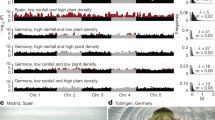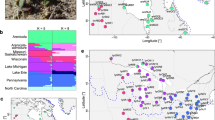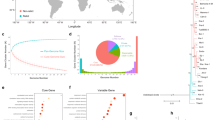Abstract
The phenotype of an individual can be affected by the genes of its conspecifics through indirect genetic effects (IGEs). IGEs have been studied across different organisms including wild and domesticated animals and plants, but little is known about their genetic architecture. Here, in a large-scale intraspecific interaction experiment, we show that the contribution of IGEs to the biomass variation of Arabidopsis thaliana is comparable to values classically reported in animals. Moreover, we identify 11 loci explaining 85.1% of the variability in IGEs. We find that positive IGE alleles (that is, those with positive effects on neighbour biomass) occur both in relict accessions from southern Eurasia and in post-glacial colonizers from northern Scandinavia, and that they are likely to have two divergent origins: for nine loci, they evolved in the post-glacial colonizers independently from the relicts, while the two others were introgressed in the post-glacial colonizer from the relicts. Finally, we find that variation in IGEs probably reflects divergent adaptations to the contrasting environments of the edges and the centre of the native range of the species. These findings reveal a surprisingly tractable genetic basis of IGEs in A. thaliana that is shaped by the ecology and the demographic history of the species.
This is a preview of subscription content, access via your institution
Access options
Access Nature and 54 other Nature Portfolio journals
Get Nature+, our best-value online-access subscription
$29.99 / 30 days
cancel any time
Subscribe to this journal
Receive 12 digital issues and online access to articles
$119.00 per year
only $9.92 per issue
Buy this article
- Purchase on Springer Link
- Instant access to full article PDF
Prices may be subject to local taxes which are calculated during checkout






Similar content being viewed by others
Data availability
The data analysed in this study are available in Zenodo: https://doi.org/10.5281/zenodo.7944154
Code availability
All the code used for statistical analysis is available in Zenodo: https://doi.org/10.5281/zenodo.7944154
References
Wisz, M. S. et al. The role of biotic interactions in shaping distributions and realised assemblages of species: implications for species distribution modelling. Biol. Rev. 88, 15–30 (2013).
Gaüzère, P. et al. The diversity of biotic interactions complements functional and phylogenetic facets of biodiversity. Curr. Biol. 32, 2093–2100 (2022).
Whitham, T. G. et al. Community and ecosystem genetics: a consequence of the extended phenotype. Ecology 84, 559–573 (2003).
Wolf, J. B., Brodie, E. D. III, Cheverud, J. M., Moore, A. J. & Wade, M. J. Evolutionary consequences of indirect genetic effects. Trends Ecol. Evol. 13, 64–69 (1998).
Griffing, B. Selection in reference to biological groups: I. Individual and group selection applied to populations of unordered groups. Aust. J. Biol. Sci. 20, 127–139 (1967).
Moore, A. J., Brodie, E. D. III & Wolf, J. B. Interacting phenotypes and the evolutionary process: I. Direct and indirect genetic effects of social interactions. Evolution 51, 1352–1362 (1997).
Griffing, B. Selection for populations of interacting genotypes. In Proceedings of the International Congress on Quantitative Genetics (eds Pollak, E. et al.) 413–434 (Iowa State Univ. Press, 1977).
Bijma, P., Muir, W. M., Ellen, E. D., Wolf, J. B. & Van Arendonk, J. A. M. Multilevel selection 2: estimating the genetic parameters determining inheritance and response to selection. Genetics 175, 289–299 (2007).
Jennings, P. R. & de Jesus, J. Studies on competition in rice I. Competition in mixtures of varieties. Evolution 22, 119–124 (1968).
Hamblin, J. Effect of environment, seed size and competitive ability on yield and survival of Phaseolus vulgaris (L.) genotypes in mixtures. Euphytica 24, 435–445 (1975).
Kawano, K. & Thung, M. D. Intergenotypic competition and competition with associated crops in Cassava. Crop Science 22, 59–63 (1982).
Murphy, G. P., Swanton, C. J., Acker, R. C. V. & Dudley, S. A. Kin recognition, multilevel selection and altruism in crop sustainability. J. Ecol. 105, 930–934 (2017).
Montazeaud, G. et al. Farming plant cooperation in crops. Proc. R. Soc. B 287, 20191290 (2020).
Muir, W. M. Group selection for adaptation to multiple-hen cages: selection program and direct responses. Poult. Sci. 75, 447–458 (1996).
Wade, M. J., Bijma, P., Ellen, E. D. & Muir, W. Group selection and social evolution in domesticated animals. Evol. Appl. 3, 453–465 (2010).
Muir, W. M. Incorporation of competitive effects in forest tree or animal breeding programs. Genetics 170, 1247–1259 (2005).
Bergsma, R., Kanis, E., Knol, E. F. & Bijma, P. The contribution of social effects to heritable variation in finishing traits of domestic pigs (Sus scrofa). Genetics 178, 1559–1570 (2008).
Alemu, S. W., Bijma, P., Møller, S. H., Janss, L. & Berg, P. Indirect genetic effects contribute substantially to heritable variation in aggression-related traits in group-housed mink (Neovison vison). Genet. Sel. Evol. 46, 30 (2014).
Ellen, E. D., Visscher, J., van Arendonk, J. A. M. & Bijma, P. Survival of laying hens: genetic parameters for direct and associative effects in three purebred layer lines. Poult. Sci. 87, 233–239 (2008).
Baud, A. et al. Dissecting indirect genetic effects from peers in laboratory mice. Genome Biol. 22, 216 (2021).
Santostefano, F., Wilson, A. J., Niemelä, P. T. & Dingemanse, N. J. Indirect genetic effects: a key component of the genetic architecture of behaviour. Sci. Rep. 7, 10235 (2017).
Xia, C., Canela-Xandri, O., Rawlik, K. & Tenesa, A. Evidence of horizontal indirect genetic effects in humans. Nat. Hum. Behav. 5, 399–406 (2021).
Tilman, D. Resource Competition and Community Structure MPB-17, Vol. 17 (Princeton Univ. Press, 2020).
Callaway, R. M. Positive interactions among plants. Bot. Rev. 61, 306–349 (1995).
Bertness, M. D. & Callaway, R. Positive interactions in communities. Trends Ecol. Evol. 9, 191–193 (1994).
Hierro, J. L. & Callaway, R. M. The ecological importance of allelopathy. Annu. Rev. Ecol. Evol. Syst. 52, 25–45 (2021).
Anten, N. P. R. & Chen, B. J. W. Detect thy family: mechanisms, ecology and agricultural aspects of kin recognition in plants. Plant. Cell Environ. 44, 1059–1071 (2021).
Crepy, M. A. & Casal, J. J. Photoreceptor-mediated kin recognition in plants. New Phytol. 205, 329–338 (2015).
Bhatt, M. V., Khandelwal, A. & Dudley, S. A. Kin recognition, not competitive interactions, predicts root allocation in young Cakile edentula seedling pairs. New Phytol. 189, 1135–1142 (2011).
Dudley, S. A., Murphy, G. P. & File, A. L. Kin recognition and competition in plants. Funct. Ecol. 27, 898–906 (2013).
Dudley, S. A. Plant cooperation. AoB Plants 7, plv113 (2015).
Cappa, E. P. & Cantet, R. J. C. Direct and competition additive effects in tree breeding: Bayesian estimation from an individual tree mixed model. Silvae Genet. 57, 45–56 (2008).
Costa e Silva, J. & Kerr, R. J. Accounting for competition in genetic analysis, with particular emphasis on forest genetic trials. Tree Genet. Genomes 9, 1–17 (2013).
Mutic, J. J. & Wolf, J. B. Indirect genetic effects from ecological interactions in Arabidopsis thaliana. Mol. Ecol. 16, 2371–2381 (2007).
Andersson, S. Indirect genetic effects from competition in the clonal herb Sedum album (Crassulaceae). PLoS ONE 9, e106104 (2014).
Subrahmaniam, H. J. et al. The genetics underlying natural variation of plant-plant interactions, a beloved but forgotten member of the family of biotic interactions. Plant J. 93, 747–770 (2018).
Becker, C. et al. The ecologically relevant genetics of plant–plant interactions. Trends Plant Sci. 28, 31–42 (2022).
Takou, M. et al. Linking genes with ecological strategies in Arabidopsis thaliana. J. Exp. Bot. 70, 1141–1151 (2019).
Horton, M. W. et al. Genome-wide patterns of genetic variation in worldwide Arabidopsis thaliana accessions from the RegMap panel. Nat. Genet. 44, 212–216 (2012).
1001 Genomes Consortium. 1,135 genomes reveal the global pattern of polymorphism in Arabidopsis thaliana. Cell 166, 481–491 (2016).
Lee, C.-R. et al. On the post-glacial spread of human commensal Arabidopsis thaliana. Nat. Commun. 8, 14458 (2017).
Exposito-Alonso, M. et al. Genomic basis and evolutionary potential for extreme drought adaptation in Arabidopsis thaliana. Nat. Ecol. Evol. 2, 352–358 (2018).
Toledo, B., Marcer, A., Méndez-Vigo, B., Alonso-Blanco, C. & Picó, F. X. An ecological history of the relict genetic lineage of Arabidopsis thaliana. Environ. Exp. Bot. 170, 103800 (2020).
Exposito-Alonso, M., Burbano, H. A., Bossdorf, O., Nielsen, R. & Weigel, D. Natural selection on the Arabidopsis thaliana genome in present and future climates. Nature 573, 126–129 (2019).
Hancock, A. M. et al. Adaptation to climate across the Arabidopsis thaliana genome. Science 334, 83–86 (2011).
Vasseur, F. et al. Climate as a driver of adaptive variations in ecological strategies in Arabidopsis thaliana. Ann. Bot. 122, 935–945 (2018).
Sartori, K. et al. Leaf economics and slow-fast adaptation across the geographic range of Arabidopsis thaliana. Sci. Rep. 9, 10758 (2019).
Estarague, A. et al. Into the range: a latitudinal gradient or a center-margins differentiation of ecological strategies in Arabidopsis thaliana? Ann. Bot. 129, 343–356 (2022).
Wuest, S. E. et al. Increasing plant group productivity through latent genetic variation for cooperation. PLoS Biol. 20, e3001842 (2022).
Green, R. E. et al. A draft sequence of the Neandertal genome. Science 328, 710–722 (2010).
Martin, S. H., Davey, J. W. & Jiggins, C. D. Evaluating the use of ABBA–BABA statistics to locate introgressed loci. Mol. Biol. Evol. 32, 244–257 (2015).
Ferrero-Serrano, Á. & Assmann, S. M. Phenotypic and genome-wide association with the local environment of Arabidopsis. Nat. Ecol. Evol. 3, 274–285 (2019).
Grime, J. P. Evidence for the existence of three primary strategies in plants and its relevance to ecological and evolutionary theory. Am. Nat. 111, 1169–1194 (1977).
Grime, J. P. & Mackey, J. The role of plasticity in resource capture by plants. Evol. Ecol. 16, 299–307 (2002).
Campbell, B. D., Grime, J. P. & Mackey, J. M. L. A trade-off between scale and precision in resource foraging. Oecologia 87, 532–538 (1991).
Rivas-San Vicente, M. & Plasencia, J. Salicylic acid beyond defence: its role in plant growth and development. J. Exp. Bot. 62, 3321–3338 (2011).
Koo, Y. M., Heo, A. Y. & Choi, H. W. Salicylic acid as a safe plant protector and growth regulator. Plant Pathol. J. 36, 1–10 (2020).
Nozue, K. et al. Network analysis reveals a role for salicylic acid pathway components in shade avoidance. Plant Physiol. 178, 1720–1732 (2018).
Yang, C. & Li, L. Hormonal regulation in shade avoidance. Front. Plant Sci. https://doi.org/10.3389/fpls.2017.01527 (2017).
Casal, J. J. Photoreceptor signaling networks in plant responses to shade. Annu. Rev. Plant Biol. 64, 403–427 (2013).
Brotherstone, S. et al. Competition effects in a young Sitka spruce (Picea sitchensis, Bong. Carr) clonal trial. Silvae Genet. 60, 149–155 (2011).
Baron, E., Richirt, J., Villoutreix, R., Amsellem, L. & Roux, F. The genetics of intra- and interspecific competitive response and effect in a local population of an annual plant species. Funct. Ecol. 29, 1361–1370 (2015).
Hartfield, M. & Glémin, S. Hitchhiking of deleterious alleles and the cost of adaptation in partially selfing species. Genetics 196, 281–293 (2014).
Filiault, D. L. et al. Amino acid polymorphisms in Arabidopsis phytochrome B cause differential responses to light. Proc. Natl Acad. Sci. USA 105, 3157–3162 (2008).
Balasubramanian, S. et al. The PHYTOCHROME C photoreceptor gene mediates natural variation in flowering and growth responses of Arabidopsis thaliana. Nat. Genet. 38, 711–715 (2006).
Maloof, J. N. et al. Natural variation in light sensitivity of Arabidopsis. Nat. Genet. 29, 441–446 (2001).
Stenøien, H. K., Fenster, C. B., Kuittinen, H. & Savolainen, O. Quantifying latitudinal clines to light responses in natural populations of Arabidopsis thaliana (Brassicaceae). Am. J. Bot. 89, 1604–1608 (2002).
Hamilton, W. D. The genetical evolution of social behaviour. I & II. J. Theor. Biol. 7, 1–52 (1964).
Bijma, P. The quantitative genetics of indirect genetic effects: a selective review of modelling issues. Heredity 112, 61–69 (2014).
Bijma, P. A general definition of the heritable variation that determines the potential of a population to respond to selection. Genetics 189, 1347–1359 (2011).
Shen, X. et al. Natural CMT2 variation is associated with genome-wide methylation changes and temperature seasonality. PLoS Genet. 10, e1004842 (2014).
Brachi, B. et al. Coselected genes determine adaptive variation in herbivore resistance throughout the native range of Arabidopsis thaliana. Proc. Natl Acad. Sci. USA 112, 4032–4037 (2015).
Brachi, B. et al. Investigation of the geographical scale of adaptive phenological variation and its underlying genetics in Arabidopsis thaliana. Mol. Ecol. 22, 4222–4240 (2013).
Gloss, A. D. et al. Genome-wide association mapping within a local Arabidopsis thaliana population more fully reveals the genetic architecture for defensive metabolite diversity. Phil. Trans. R. Soc. B 377, 20200512 (2022).
Atwell, S. et al. Genome-wide association study of 107 phenotypes in Arabidopsis thaliana inbred lines. Nature 465, 627–631 (2010).
R Core Team. R: A Language and Environment for Statistical Computing (R Foundation for Statistical Computing, 2019).
Butler, D., Cullis, B., Gilmour, A., Gogel, B. & Thompson, R. ASReml-R Reference Manual Version 4 (VSN International, 2017).
Vilhjálmsson, B. J. & Nordborg, M. The nature of confounding in genome-wide association studies. Nat. Rev. Genet. 14, 1–2 (2013).
Benjamini, Y. & Hochberg, Y. Controlling the false discovery rate: a practical and powerful approach to multiple testing. J. R. Stat. Soc. B 57, 289–300 (1995).
Clayton, D. snpStats: SnpMatrix and XSnpMatrix classes and methods. R package version 1.50.0. Bioconductor https://doi.org/10.18129/B9.bioc.snpStats (2023).
Whiting, J. R. JimWhiting91/genotype_plot: Genotype Plot. Zenodo https://doi.org/10.5281/zenodo.5913504 (2022).
Zhou, X. & Stephens, M. Genome-wide efficient mixed-model analysis for association studies. Nat. Genet. 44, 821–824 (2012).
Purcell, S. et al. PLINK: a tool set for whole-genome association and population-based linkage analyses. Am. J. Hum. Genet. 81, 559–575 (2007).
Hill, W. G. & Weir, B. S. Variances and covariances of squared linkage disequilibria in finite populations. Theor. Popul. Biol. 33, 54–78 (1988).
Global Land Cover 2000. European Commission https://forobs.jrc.ec.europa.eu/glc2000 (2003).
Obenchain, V. et al. VariantAnnotation: a Bioconductor package for exploration and annotation of genetic variants. Bioinformatics 30, 2076–2078 (2014).
Weir, B. S. & Cockerham, C. C. Estimating F-statistics for the analysis of population structure. Evolution 38, 1358–1370 (1984).
De Mita, S. & Siol, M. EggLib: processing, analysis and simulation tools for population genetics and genomics. BMC Genet. 13, 27 (2012).
Acknowledgements
We thank C. Fankhauser, T. Kay and Q. Pan for their helpful comments on the manuscript and A. Estarague, F. Vasseur and C. Violle for insightful discussions. This work was supported by the University of Lausanne, the European Union’s Horizon 2020 research and innovation programme under the Marie Skłodowska-Curie grant agreement SOCLE (no. 101030712) to G.M. S.E.W. acknowledges funding from the Swiss National Science Foundation, project no. 310030_192537.
Author information
Authors and Affiliations
Contributions
G.M. and S.E.W conceptualized the study based on data previously collected by S.E.W. G.M. conducted the quantification of IGEs, the GWAS and the GEAs. G.M. and Q.H. performed introgression tests and investigated candidate genes. G.M. wrote the manuscript with L.K. All the authors commented on the manuscript. L.K. advised and oversaw the project.
Corresponding authors
Ethics declarations
Competing interests
The authors declare no competing interests.
Peer review
Peer review information
Nature Ecology & Evolution thanks Amelie Baud, Julin Maloof and the other, anonymous, reviewer(s) for their contribution to the peer review of this work. Peer reviewer reports are available.
Additional information
Publisher’s note Springer Nature remains neutral with regard to jurisdictional claims in published maps and institutional affiliations.
Supplementary information
Supplementary Information
Supplementary Tables 1–2 and Figs. 1–14.
Supplementary Data 1
List of genes with at least one non-synonymous or frameshift mutation that is in proximity and in high linkage with an SNP significantly associated with IGE.
Rights and permissions
Springer Nature or its licensor (e.g. a society or other partner) holds exclusive rights to this article under a publishing agreement with the author(s) or other rightsholder(s); author self-archiving of the accepted manuscript version of this article is solely governed by the terms of such publishing agreement and applicable law.
About this article
Cite this article
Montazeaud, G., Helleu, Q., Wuest, S.E. et al. Indirect genetic effects are shaped by demographic history and ecology in Arabidopsis thaliana. Nat Ecol Evol 7, 1878–1891 (2023). https://doi.org/10.1038/s41559-023-02189-4
Received:
Accepted:
Published:
Issue Date:
DOI: https://doi.org/10.1038/s41559-023-02189-4



